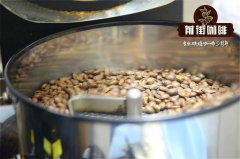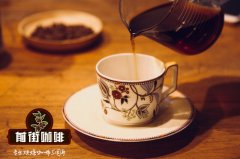Organic certification | White Nile producing area in northern Uganda | slow drying washing method Katim, SL14

Professional coffee knowledge exchange more coffee bean information please follow the coffee workshop (Wechat official account cafe_style)
Organic certification | White Nile producing area in northern Uganda | slow drying and washing Fakadim, SL14 flavor?
Organic coffee comes from the high altitudes of the white Nile in northern Uganda. In the process of treatment, the unripe beans are screened by washing, washing and peeling for one hour, then moved to an elevated bed to dry in the sun for two weeks, and then dried in a centrifuge for 48 hours until the target moisture content is reached. The white Nile treatment plant uses volcanic rocks to recover the waste water produced during the washing process.
Uganda, which became independent in 1962, is a country lacking agricultural land in North Africa, with many mountains and lakes. Most people live in southern Uganda, and the Nile basin in northern Uganda has a humid and warm climate. Uganda's natural environment has fertile soil and stable rainfall. 80% of Uganda's employed population are farmers, and coffee is the third largest export agricultural product after cotton and tea.
Uganda, located at the source of the Nile, is a landlocked country in Africa that does not rely on the sea. Although Uganda has a long history of producing coffee like other East African countries, the quality of coffee has never been improved because of the war caused by ethnic antagonism. good coffee is mostly grown in areas adjacent to Kenya, and some good coffee beans are shipped to Kenya to be sold as Kenyan coffee. It was not until the end of the war 15 years ago that Uganda leapt into a fast-growing country of coffee. Uganda is a country with lush green forests, lakes, wetlands and rivers. Coffee is the largest crop in Uganda and earns the most foreign exchange. About 500000 coffee farms are engaged in coffee-related agriculture, accounting for 25% of the total population. Coffee trees are mostly robusta coffee trees, accounting for 94%. Only 6% of coffee is a traditional Arabica tree. These rare coffee beans are grown in tropical rainforests and most of them are exported to countries around the world.
Uganda coffee grade is the same as Kenya, AA grade is the best, which represents the coffee bean size is uniform and uniform, but this grading system will vary according to the evaluation of each manor. For example, Manor An is better than Manor B, even if the AB bean of Manor An is also better than the AA bean of Manor B. Coffee is sold through two kinds of pipes: fine products auction and direct sale, if the fineness of the treatment process and the elimination of missing beans are strengthened. It is believed that it can get better sales under the condition of high coffee prices in Kenya and Ethiopia.
■ country: Uganda
■ producing area: White Nile region
■ varieties: Catimorn (30%), SL14 (70%)
■ altitude: 1450m-1800m
■ treatment: slow drying and washing
■ certification: organic certification
■ reference flavor: raisins, spices, chocolate, western pear, excellent mellow thickness, long sweet rhyme
Qianjie recommended cooking:
Filter cup: Hario V60
Water temperature: 90 degrees
Degree of grinding: small Fuji 3.5
Cooking methods: the ratio of water to powder is 1:15, 15g powder, the first injection of 25g water, 25 s steaming, the second injection to 120g water cut off, waiting for the powder bed water to half and then water injection, slow water injection until 225g water, extraction time about 2:00
Analysis: using three-stage brewing to clarify the flavor of the front, middle and back of the coffee. Because V60 has many ribs and the drainage speed is fast, it can prolong the extraction time when the water is cut off.
Important Notice :
前街咖啡 FrontStreet Coffee has moved to new addredd:
FrontStreet Coffee Address: 315,Donghua East Road,GuangZhou
Tel:020 38364473
- Prev

Analysis of Coffee brewing in Diamond Manor in Costa Rica _ COE8 anaerobic treatment of coffee beans
Professional coffee knowledge exchange more information about coffee beans Please follow the coffee workshop (Wechat official account cafe_style) anaerobic fermentation, as the name implies, is the fermentation reaction carried out in the absence of oxygen. The main microorganisms supporting this fermentation reaction are lactic acid bacteria and yeasts. Lactic acid bacteria is a kind of anaerobic bacteria, which needs to survive in a hypoxic environment. Yeast is a kind of
- Next

Gimbi Kinby producing area of Ethiopia | Native species of Queen Queen Sheba of Sheba
Professional coffee knowledge exchange more coffee bean information please follow the coffee workshop (Wechat official account cafe_style) Ethiopia Gimbi producing area | Sun Sheba Queen Queen Sheba local native species flavor? According to the Old Testament Bible and the Koran, Queen of Sheba (Queen Sheba) was the ruler of the kingdom of Sheba at the same time as King Solomon. At that time, it was powerful and powerful.
Related
- Detailed explanation of Jadeite planting Land in Panamanian Jadeite Manor introduction to the grading system of Jadeite competitive bidding, Red bid, Green bid and Rose Summer
- Story of Coffee planting in Brenka region of Costa Rica Stonehenge Manor anaerobic heavy honey treatment of flavor mouth
- What's on the barrel of Blue Mountain Coffee beans?
- Can American coffee also pull flowers? How to use hot American style to pull out a good-looking pattern?
- Can you make a cold extract with coffee beans? What is the right proportion for cold-extracted coffee formula?
- Indonesian PWN Gold Mandrine Coffee Origin Features Flavor How to Chong? Mandolin coffee is American.
- A brief introduction to the flavor characteristics of Brazilian yellow bourbon coffee beans
- What is the effect of different water quality on the flavor of cold-extracted coffee? What kind of water is best for brewing coffee?
- Why do you think of Rose Summer whenever you mention Panamanian coffee?
- Introduction to the characteristics of authentic blue mountain coffee bean producing areas? What is the CIB Coffee Authority in Jamaica?

